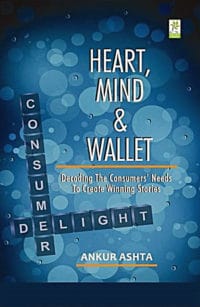RESEARCH: 3.5/5
RELEVANCE: 4/5
WRITING STYLE: 4.5/5
ENTERTAINMENT QUOTIENT: 4/5
In these times of cut-throat competition, when corporates all over the world are fighting for a thin slice of market share, companies are becoming even more focused on reaping the benefits of understanding consumer insights.
As such, the advertising and branding media space is getting ever more flooded with a whole lot of new ideas and marketing campaigns.
But what really clicks with the customers? What really makes certain companies/products hit and certain companies/products fail?
Ankur Ashta with the help of his unfussy book gives a deep understanding of what really matters in the cruel brutal world of marketing where the only thing which matters is: Customer (the King).
What I liked best about Heart, Mind & Wallet were its easy language and equally simple examples. Most of the concepts mentioned in the book are explained in context to India and Indian consumers with a light sprinkle of a few foreign market examples too.
Success and failures stories of many products and campaigns are efficiently used to bring forth the point being discussed.
For people who have issues digesting heavy concepts and lengthy descriptions, this book is just the right one for you because the beauty of this book lies in its succinctness and brevity.
Ankur Ashta starts with a concept, illustrates with an example, talks a little more about the concept by borrowing a few bits from other relevant books and moves on to the end by again substantiating his concept with a broader and detailed example.
I think this approach is highly effective and helps a lot in pushing the concept deep into the minds of the reader. The vivacity and the variedness of the examples (spread generously across industries and across decades) also facilitate comprehension.
I particularly liked the examples of Amul ice cream pushcarts, Le Sancy shampoo and Dainik Bhaskar and how these companies succeeded or failed in what they did.
Considerable and meticulous research has gone into each chapter and each source of information is mentioned in the way of note or bibliography.
There were a few books which the author drew inspiration from and borrowed a few paragraphs from, which he has frequently quoted throughout the course of the books.
These books include Dan Ariel’s “Predictably Irrational”, Sheena Iyengar’s “The Art of Choosing”, Rama Bijapurkar’s “We are Like That Only” and Porus Munshi’s “Making Breakthrough Innovation Happen”.
The way the author mentions the books and the paragraphs borrowed from them make the book seem absolutely indispensable and needless to say a few of them including Sheena Iyengar’s “The Art of Choosing” have become the latest additions to my “to-read” wish list.
All in all, Heart, Mind & Wallet is quite insightful and useful especially for somebody working in the field of marketing (including aspiring marketers).
Thus, I recommend it as a must-read to all management students and working sales and/or marketing professionals. You will not find a more interesting book on consumer insights than this one.
Was this review helpful? Let us know in the comments below.
